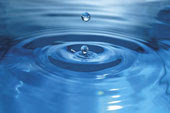Even though we may have kind of a wet start too summer here in Alberta, ponds are starting to look pretty green.
The question is why do we get algae growth in our ponds and why more so the past couple years.
The unique benefit of water is that it absorbs anything you add to it. The negative side to this is that also debris such as dead plant material,leaves, pollen and so on are absorbed and start the fermenting process. Algae is formed to clean this up. If you have a deep pond this process would take some time and then the algae would disappear, however in a shallow environment the water is warmer and the algae sticks around for a longer period of time. Algae is also fed by minerals from run off as well as the nitrates coming down with rain. This is not often thought off but as nitrate concentration increases so will the algae.
There are ways to control or even reduce algae in ponds without the use of chemicals.
Through a revitalization process the water can be cleaned up and your pond will again be a refreshing site to see.
Thursday, June 17, 2010
Monday, June 7, 2010
Bacteria and well water
Last time we spoke about bottled water and possible contamination.
Today a quick look at the challenges that well water may provide as it relates to bacteria.
Most well water passes for contamination levels such as total coliform and e-coli however there are 2 bacteria groups cryptosporidium and giardia that are usually not tested for.
Last week these 2 groups of bacteria were in the news again. A few years ago a survey in the US reported that 50% off the wells surveyed contained these bacteria.
Better safe then sorry advice would be to do one of 2 things.
1. Test your water for these bacteria.
2. Implement a strategy to eliminate these bacteria.
Several options are available depending on your unique situation.
Today a quick look at the challenges that well water may provide as it relates to bacteria.
Most well water passes for contamination levels such as total coliform and e-coli however there are 2 bacteria groups cryptosporidium and giardia that are usually not tested for.
Last week these 2 groups of bacteria were in the news again. A few years ago a survey in the US reported that 50% off the wells surveyed contained these bacteria.
Better safe then sorry advice would be to do one of 2 things.
1. Test your water for these bacteria.
2. Implement a strategy to eliminate these bacteria.
Several options are available depending on your unique situation.
Friday, June 4, 2010
Bacteria in Bottled Water
The CBC reported last week that 70% of bottled water surveyed contained bacteria rates that were above safe limits. Hetrophic bacteria can include e-coli and salmonella, which are cause of many deaths every year.
A couple of observations:
1. Bottled water is subject to higher storage temperatures which can increase growth rates of bacteria. Therefore bottled water should be stored in the fridge to minimize this effect.
2. it's obvious that by trying to solve one challenge (Provision of healthy and safe drinking water) we subject ourselves to 2 challenges. The second being the amount of plastic that polutes our environment.
Is it time to reconsider our choices?
There are other choices such as treating tap water in your own home.
A couple of observations:
1. Bottled water is subject to higher storage temperatures which can increase growth rates of bacteria. Therefore bottled water should be stored in the fridge to minimize this effect.
2. it's obvious that by trying to solve one challenge (Provision of healthy and safe drinking water) we subject ourselves to 2 challenges. The second being the amount of plastic that polutes our environment.
Is it time to reconsider our choices?
There are other choices such as treating tap water in your own home.
Thursday, June 3, 2010
Introduction
Water is the key to life. There is a lot we know about water but there is much more to be discovered.
How does water influence our lives?
The short answer to this is that it influences our lives much more then we often realize.
In fact it is very interesting to learn how much water is required to provide us with the current lifestyle that we live. Not only is there the everyday use of water for hydration, cleanliness and keeping us at comfortable temperatures. It also is used in great quantities to provide for our daily nutrient requirements. The fruits, veggies and meats that we consume all rely on the same principles.
Today we are faced with 2 challenges that have a major impact on our daily life but also will challenge us for the future.
How does water influence our lives?
The short answer to this is that it influences our lives much more then we often realize.
In fact it is very interesting to learn how much water is required to provide us with the current lifestyle that we live. Not only is there the everyday use of water for hydration, cleanliness and keeping us at comfortable temperatures. It also is used in great quantities to provide for our daily nutrient requirements. The fruits, veggies and meats that we consume all rely on the same principles.
Today we are faced with 2 challenges that have a major impact on our daily life but also will challenge us for the future.
- Quality of water
- Quantity of water
In following posts we will continue to dig into this phenomenon water and how we can maximize it's potential to contribute positively to our lives.
Until then "Have a great day"
Subscribe to:
Comments (Atom)
